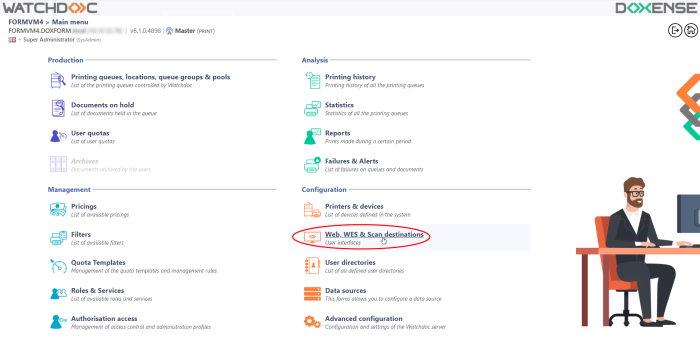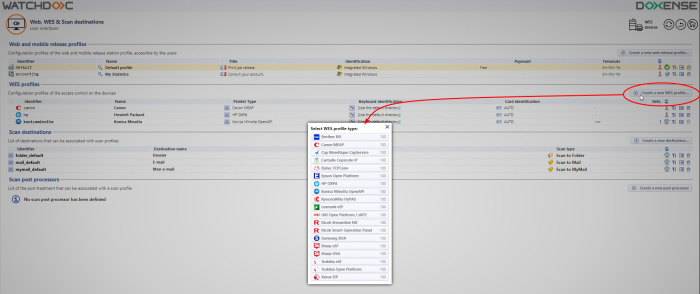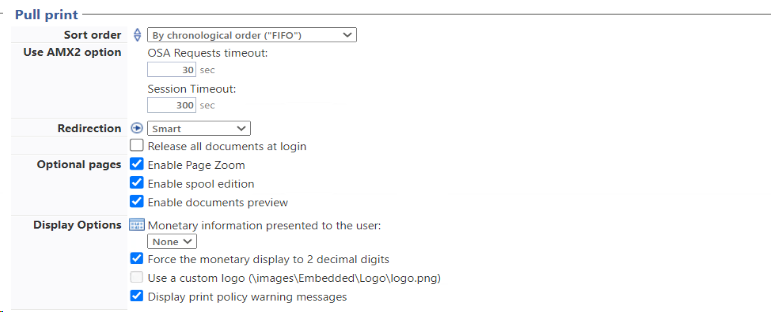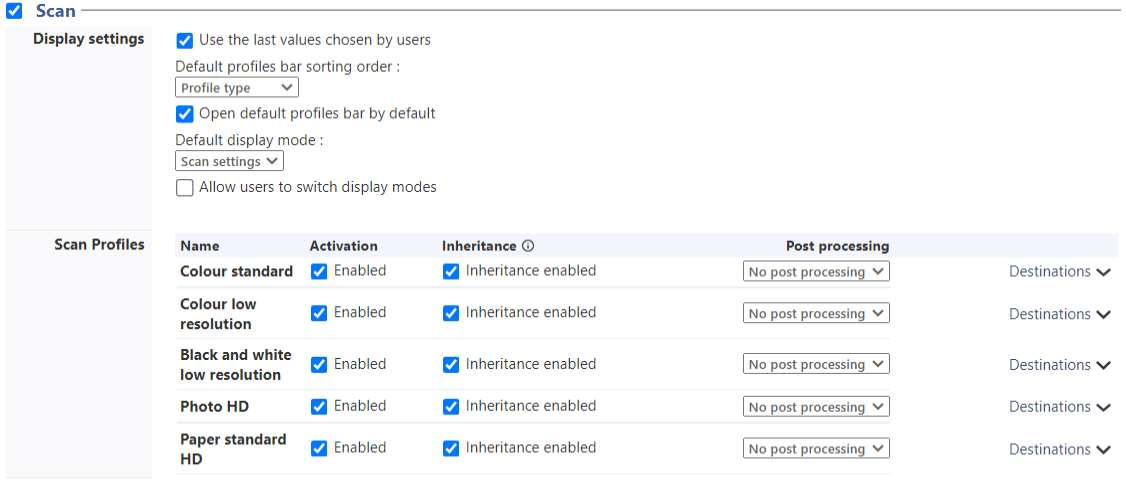WES Sharp - Create and configure the WES profile
Create the WES profile
On a clean Watchdoc installation, a first WES profile is automatically created with default parameters at the end of the wizard procedure, but you can, at any time, edit existing profiles to modify them or create a new profile.
-
From the Main menu in the administration interface;
-
in the Configuration section, click on Web, WES & Scan destinations:

-
in the Web, WES & Scan Destinations - Client Interface Management interface, click on Create a new WES profile;
-
in the list, select the profile you want to create:

è you will access the Create a WES profile form, which contains a number of sections in which you can configure your WES.
A navigation bar helps you quickly access the desired section:
Configure the WES profile
Configure the Properties section
Use this section to state the main WES properties:
-
Identifier: Enter the single identifier for the WES profile. It can comprise letters, numbers and the '_' character with a maximum of 64 characters. This identifier is only displayed in the administration interfaces.
-
Name: Enter the WES profile name. This explicit name is only displayed in the administration interfaces.
-
Application OSA - option AMX2: Tick when activating WES V3 (optional in V2).
-
Global: In the case of a domain configuration (master/slaves), tick this box to replicate this profile on the slave servers.
-
Language: Select the WES display language configured from the list. If you select Automatic detection, the WES adopts the language it finds by default in the device configuration.
-
Version: Select the version of WES. For v3, you can customise the interface by choosing the colour of the buttons and images to match your graphic identity:
-
Colour: enter the Hexadecimal color value corresponding to the WES button's colour. By default, the buttons are Watchdoc orange customized (#FF901). Once the value is entered, the colour is displayed in the field.
-
Images: if you want to customize the WES images, enter the folder path in which are recorded images you want to display instead of the default images (stored in C:\Program Files\Doxense\Watchdoc\Images\Embedded\Doxense\[Manufacturer_Name] by default).

-
Configure the keyboard authentication mode
-
Keyboard authentication: tick the box (at the section level) to enable user authentication from a physical keyboard or the touch screen one, then set out how this authentication works:
Standard - Login (PUK
(Print User Key). In Watchdoc, this is a code (associated with a user account but used alone) sufficient to allow the user to authenticate in a WES. The PUK code is generated thanks to an algorithm. The user can consult it in the "My account" page of Watchdoc. For security reasons, we advise against using the PUK code and recommend using a login (user account)/PIN code. Code): the PUK code is automatically generated by Watchdoc according to the parameters defined in the directory and communicated to the user on the "My account" page.
Standard - Login and PIN Code: consisting of 4 or 5 digits, the user PIN code (1234, for example) is registered as anLDAP attribute or in a CSV file. It is associated to the user login (available with the Watchdoc 5.1 version).
Standard - Login and password: users will use their LDAP credentials. We do not recommend using this mode :
-
Directory: From the list, select the directory to query during keyboard authentication. If no directory is set, Watchdoc will query the default directory.
Gallery: This mode allows users to search for their account in a list using a specific identification attribute, and then complete their authentication using a second attribute. If the user cannot find his account directly in the gallery, a search engine is available.
Search type:
strict: select this type if the search criterion must correspond strictly to the value recorded in the directory (exact search);
smart: select this type if the search criterion should partially match the value recorded in the directory (approximate search, 3 characters minimum: "der" finds ‘Derrick’, ‘Underwood’ and 'Fielder’). In this case, specify which directory attribute the search is for:
login: account with which the user authenticates to the WES;
full name: the first name and surname of the user registered in the directory;
mail: email address of the user registered in the directory.
Primary field:From the list, select the main search criterion;
Secondary field: From the list, select the secondary search criterion;
Nb. max. or results: specify the maximum number to be displayed in the list of results.
-
Directory: From the list, select the directory to query during keyboard authentication. If no directory is set, Watchdoc will query the default directory.
Configure the card authentication section
Card authentication: tick the box (at the section level) to enable user authentication from a card, then set out how this authentication works:
-
Directory: From the list, select the directory to query during cards authentication. If no directory is set, Watchdoc will query the default directory.
-
Self registration : If you enable the self-registration
 An action in which a user account is associated with its own card code. Registration is carried out the first time a card is used. The registration can be carried out by the IT manager when he issues the card to a user or by the user himself who enters his identifier (PIN code, PUK code or username and password) which is then associated with his card code. Once the registration is completed, the card code is permanently associated with its owner. from the WES, state how the user assigns their card to their account:
An action in which a user account is associated with its own card code. Registration is carried out the first time a card is used. The registration can be carried out by the IT manager when he issues the card to a user or by the user himself who enters his identifier (PIN code, PUK code or username and password) which is then associated with his card code. Once the registration is completed, the card code is permanently associated with its owner. from the WES, state how the user assigns their card to their account: -
Disabled: the self-registration is not allowed: if the user is unknown, an error message is displayed;
-
with PUK code: the embedded solution will ask the user for its PUK code. If the PUK code is correct, Watchdoc® stores the card number with the user's login in its database;
-
with login and PIN code: the embedded solution will ask the user for his login and his PIN code.
-
with login and password: the embedded solution will ask the user for his login and his password. If the data keyed in are correct, Watchdoc stores the card number with the user's login in its database.
-
with login and printcode: the embedded solution will ask the user for his login and his PIN code. The user must enter its printcode in the "My Account" page.
-
Notify the user on self-registration: check this box to send a notification to the user when his badge has been enrolled.
-
Format : State, where necessary, how the character string for the badge number string is to be transformed. E.g. raw;cut(0,8);swap.
-
HID:
-
Enable HID Card reader: indicate, in seconds, the time to wait before a second badge swipe is taken into account (5s < Time < 15s)
-
Fix card number: if there are any problems reading the badges, tick this box to correct them. With some older firmware, the badge numbers may not be read correctly:

-
Configure the Anonymous section
Tick this section to activate the Anonymous connection in order to allow an unauthenticated user to access to the device by clicking a button.
It is possible to restrict the features that the anonymous user can access by applying a privilege policy to the queue, group, or server, and using the Anonymous User filter.
-
Button Label: Enter in this field the label displayed on the access button to the device features. By default, the text is Anonymous;
-
Redirection: From the list, choose the application to which the anonymous user must access after clicking the Anonymous:
-
Home: The user accesses to the device homepage;
-
Copy Application: The user accesses to the copy application;
-
Scan Application: The user accesses to the scan feature;
-
Fax application: The user accesses to the scan feature;

-
Configure the Accounting section
In this section, specify whether you want the accounting to be performed by the device itself or from the Watchdoc parser.
- Device > Uses the prints accounting information from the device : tick this box if you want accounting to be supported by the device instead of the Watchdoc parser. This only applies to print jobs. Results are more reliable especially when the job is not fully printed (canceled).
-
Security > Allow anonymous printing: tick this box to accept printing by non-authenticated users. In this case, the print jobs are assigned to an Anonymous virtual account. If you wish to assign these print jobs to another account, enter this account in the User account field, in the form of domain\account.
-
Password Required: Select this check box to require users to enter their password in the Sharp driver or mobile application settings. If the password is missing, printing is considered anonymous and will be rejected if anonymous printing is not allowed.
-
Domain: this parameter should be configured in specific cases of accounting inconsistencies. In some cases, the domain of the user who initiated print jobs and the domain recognised by the print device do not match. In this case, the accounting of print jobs can be distorted.
-
Ignore the domain returned by the device and use the user's domain as authenticated in the WES;
-
-
Give priority to the domain sent by the device or, if this is absent, to the user's domain;
-
Give priority to the domain sent by the device, or treat the job as anonymous;
-
Use the domain selected from the list shown:

Configure the redirection management section (from v. 6.1.0.5290)
Configure here the WES operation with or without the AMX2 / BP-AM10 option (see Installation prerequisites).
-
Application OSA - AMX2- BP-AM10 option: tick the box to use the WES with the AMX2 / BP-AM10 option. In this case, a specific screen is displayed after authentication to give access to the Watchdoc, WEScan and device functions.
If you do not tick the box, the WES uses the AMX3 / BP-AM11 option with the classic WES v. 3 functions (but without access to WEScan). -
Redirection: if the user has no print jobs waiting, specify the behaviour of the WES:
-
Smart: the WES displays the default home interface;
-
Ask user: if there are jobs waiting, the WES goes directly to the jobs page or, if there are no jobs waiting, it goes to the device menu.
-
Waiting jobs: the WES displays the list of pending documents even if there are none.
-
Home: the device's default home interface is displayed ;
-
Scan application: the device's scanning interface is displayed;
-
Easy Scan application: the device's easy scanning interface is displayed;
-
Copy application: the device's photocopying interface is displayed;
-
Easy Copy application: the device's easy photocopying interface is displayed;
-
Fax: the machine's fax interface is displayed.
-
Easy Fax: the machine's easy fax interface is displayed.
-
-
Menu content: click on Add an entry to select the application(s) to be displayed on the device screen:

Configure the Pull-print section
In this section, you can change options about the Watchdoc® release application: sort order of the document, tariff information and optional pages.
You can bypass this application by enabling the automatic release mode. When the user is authenticated on the device, all its documents are released.
-
Sort Order: Set the documents order on the device screen:
-
Reverse chronological: More recent documents will top the list ;
-
Chronological: Older documents will top the list.
-
-
Use AMX2 option:
-
OSA request timeout: Maximum request duration: specify, in seconds, the period of inactivity after which requests are no longer executed;
-
Session Timeout: Specify, in seconds, the duration of inactivity after which the user who has logged on to the WES is automatically logged off.
-
-
Redirection: if the user has no print jobs waiting, specify the behaviour of the WES :
-
Smart: the WES displays the default home interface;
-
Ask the user: the WES goes directly to the pending jobs page if there are any, or to the device menu if there are no pending jobs.
-
Waiting jobs: the WES displays the list of pending documents even if there are none.
-
Copy application: the machine's copy interface is displayed;
-
Scan application: the machine's scanning interface is displayed;
-
Fax: the machine's fax interface is displayed.
-
-
Release all documents at login: When the user logs on, Watchdoc releases all user documents on the device where he logs on. In this case, the user cannot access the list of pending jobs to delete or print them.
-
All documents are checked by default: tick the box to ensure that all pending jobs are automatically ticked in the list of pending jobs when the user authenticates.
-
Optional pages: Tick the box o enable user adding more pages previews:
-
Enable Page Zoom: User can have a page by page preview (PCL 6 driver required)
-
Enable spool edition: User can modify the initial printing criteria;
-
-
Display Options: from the list, select the pricing information displayed to the user via the WES: none, the price or the cost of their printouts.
-
Force the monetary display to 2 decimal digits: Tick the box to limit the number of decimal digits displayed to the user in the tariff information.
-
Use a custom logo: (for WES V2 only) tick the box if you want to display a custom logo instead of the default Watchdoc logo.
-
Display print policy warning messages: tick this box if you wish to inform users of the printing policy in place which could change their initial choices.

-
Configure the Quota section
- Activate the option: tick the box to enable the WES to manage print quotas

If you tick the box, complete the configuration :
by adding at least one quota ;
by applying the VMS and rates to the print queues associated with the WES
by specifying the pricing information presented to the user in the Print on Demand section.
Configure the Scan section
This section is used to configure the WEScan function. It can only be activated with a WES V3.
-
Display preferences- Use the last values chosen by users: allows the user to be offered the most used scanning profiles (predefined settings), which offers a time saving when scanning uses are often the same. Then specify whether the classification should be done using:
-
the type of profile: (the most frequently chosen profile);
-
the date of use (profile chosen the last time it was used).
-
-
Open default profile bar: provides an interface in which the user can choose between all the scanning parameters, which is useful when the scanning uses are very varied. Then specify whether you want to display the settings or the (pre-set) profiles.
-
the scan settings ;
-
the scan profiles (pre-configured).
-
-
Allow users to switch display modes: tick this box to allow the user to customize their interface by choosing their preferred display mode.
-
Scan profiles: for each profile listed, you can check:
-
activation: to make it active in the embedded interface;
-
inheritance: to allow the user to create a new profile inheriting the parameters of the existing profile. The user will then be free to modify one or more parameters of the original profile;
-
Post processing: if a post-scan treatment has been configured (see Post-scan processor), select it from the list ;
-
destinations : the destination is the place where the scanned document is sent. For each profile, you can activate, deactivate and define one or more destinations by default:
-
E-mail: Send the scan to the e-mail of a recipient entered in the interface;
-
My e-mail: send the scan to the user's email (always known if the user has an AD account);
-
Folder: send the scan to a predefined folder in the workspace accessible to the user.

-
-
Configure the Device section
This section is used to define the connection mode between the server and the print devices.
-
Fault tolerance: tick this box to enable fault tolerance based on load-balancing. If you enable this function, you will need to configure interserver printing (see Configuring interserver printing).
-
Server Address type: The device needs to contact the Watchdoc server when the user tries to connect or wants to release his documents. You can specify the Watchdoc server address in three different ways: IP Address, DNS Address and Custom Address ;
-
Network: the two values can be used to set :
-
the maximum waiting time for the connection between the copier and Watchdoc during a request (server off or service stopped);
-
the waiting time for processing the request: retrieving information about a user, sending and processing accounting requests.
-
OSA Port: 443 if you are using the secure port using the SSL protocol; 80 if you are using the non-secure port using the SSL protocol.
-
TLS/SSL: tick the following boxes if you wish to secure :
-
SOAP calls to the device
-
SOAP calls from the device
-
pages displayed on the device screen;
-
-
Credentials: enter the administrator login and password required to configure the device in the field.

-
Configure the Misc. section
In this section, you configure the behaviour of print devices in the event that the Watchdoc server does not respond.
-
Ping delay: specify, in seconds, how often the device should poll the server to check its configuration and inform it that it is working correctly:

Validate the profile
1. Click on the  button to validate the WES profile configuration.
button to validate the WES profile configuration.
→ Once validated, the WES profile can be applied to a print queue.

